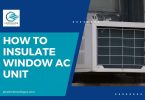Introduction
As the summer season approaches, it becomes crucial to safeguard various aspects of your home, especially ventilation systems and vents exposed to external temperatures. One such area that requires attention is your dryer vent. Protecting your dryer vent from potential damage is essential for its efficient operation. In this guide, we will explore a simple method to insulate your dryer vent and provide you with the necessary steps to ensure proper insulation.
Why Dryer Vent Insulation Matters
Dryer vents play a vital role in your home, facilitating the safe release of moist air generated during the drying process. These metal pipes extend from your tumble dryer to the exterior of your house, preventing the accumulation of harmful elements within the home. Proper insulation of dryer vents becomes essential to avoid potential issues and ensure the longevity of the ventilation system.
Signs of Clogged Dryer Vents
Clogged dryer vents can lead to several problems, including:
1. Extended Drying Time: Clothes may take longer to dry, requiring multiple cycles instead of a single one.
2. Accumulation of Debris: Residue and lint may accumulate, appearing on clothes towards the end of the drying cycle.
3. Risk of Fires and Health Issues: Clogged vents increase the risk of fires, especially in gas dryers, and can result in health issues such as respiratory complications.
The Importance of Dryer Vent Insulation
Insulating your dryer vent serves several purposes, including:
1. Preventing Freezing: Insulation helps prevent the vent line from freezing during cold temperatures.
2. Protecting Surrounding Structures: Insulation safeguards the surrounding structures from potential damage caused by vent line issues.
3. Avoiding Clogging: Insulation prevents falling precipitation, like snow, from obstructing the vent.
Choosing the Right Insulation
Fiberglass insulation is recommended for insulating dryer vents. The choice may vary based on availability and vent location. Consider the R-value of the insulation, especially in colder climates, where a higher R-value indicates better resistance to heat flow.
Step-by-Step Instructions for Dryer Vent Insulation
Follow these step-by-step instructions to effectively insulate your dryer vent:
1. Locate the Dryer Vent Exit:
– Identify the outward exit point of your dryer vent from the house. This is typically where the washer and dryer have hook-ups on the exterior.
2. Trace the Vent Line:
– Run the dryer and trace the steam to locate the vent’s exit point. This will guide you to the vent’s location inside the house.
3. Prepare Materials:
– Gather insulation, duct tape, a utility knife, a caulking gun, and waterproof caulk.
4. Wrap the Vent Line:
– Fold the insulation over the vent line, covering each layer by at least an inch to ensure complete coverage. Use duct tape to secure each layer, overlapping by an inch.
5. Caulk the Exit Point:
– Caulk the area where the dryer vent exits the house, preventing outside air from leaking through the opening.
By following these simple steps, you can insulate your dryer vent effectively and protect it from potential issues.
Conclusion
Insulating your dryer vent is a practical and beneficial step for homeowners. It helps prevent clogs, freezing, and potential damage to surrounding structures. In this guide, we’ve covered the importance of dryer vent insulation, signs of clogged vents, and provided step-by-step instructions for proper insulation. Taking these measures ensures the efficient and safe operation of your dryer vent, contributing to a healthier home environment.
Disclosure: We may get commissions for purchases made through links in this post.








